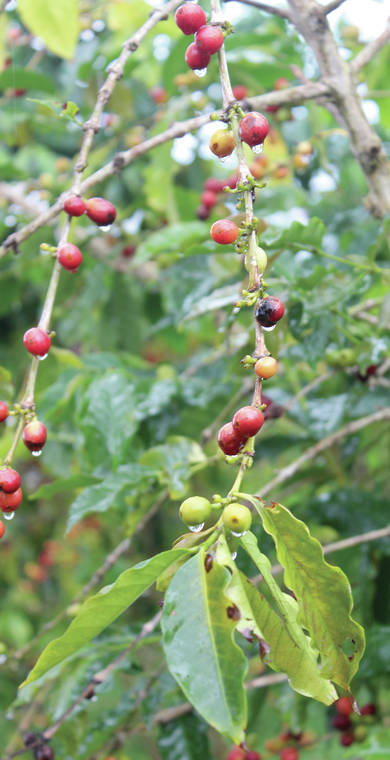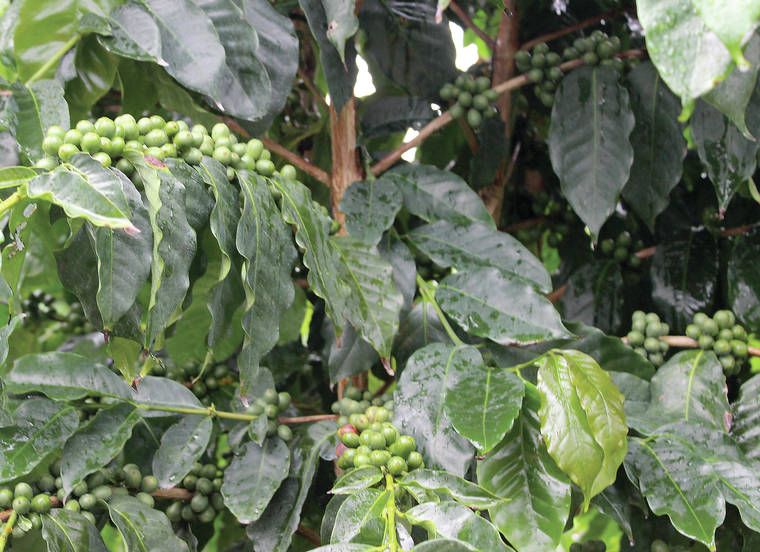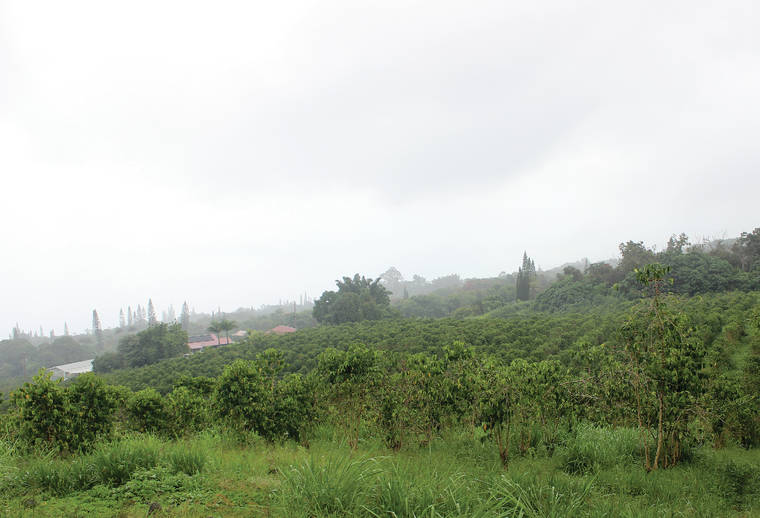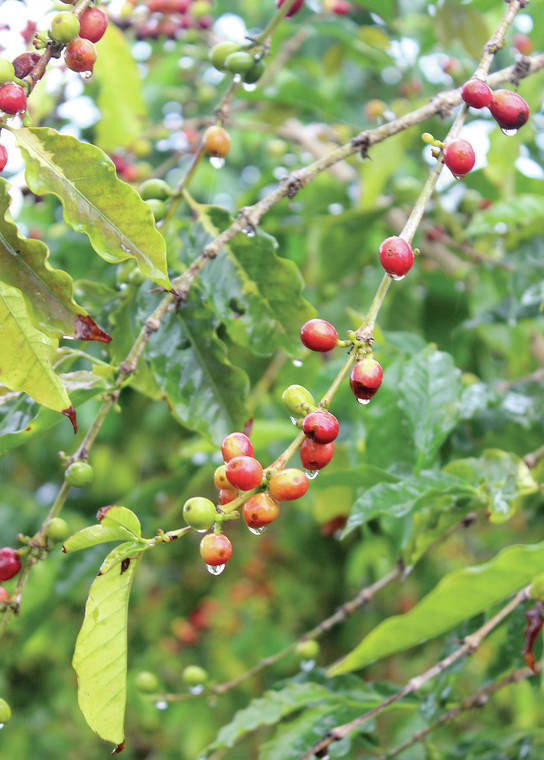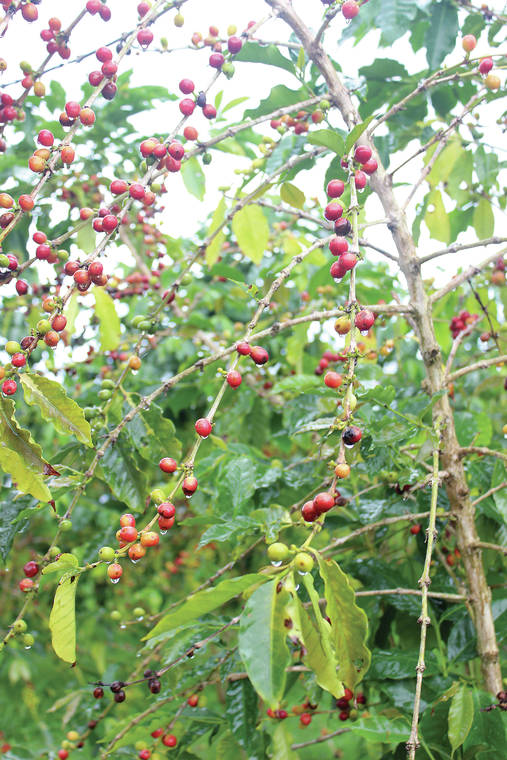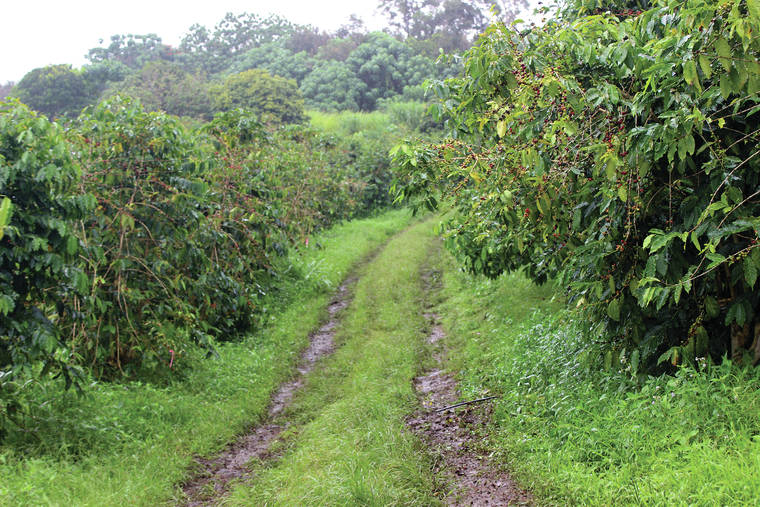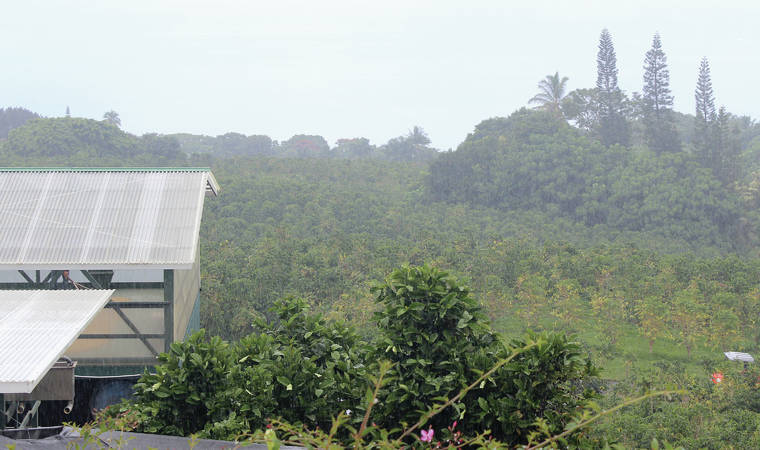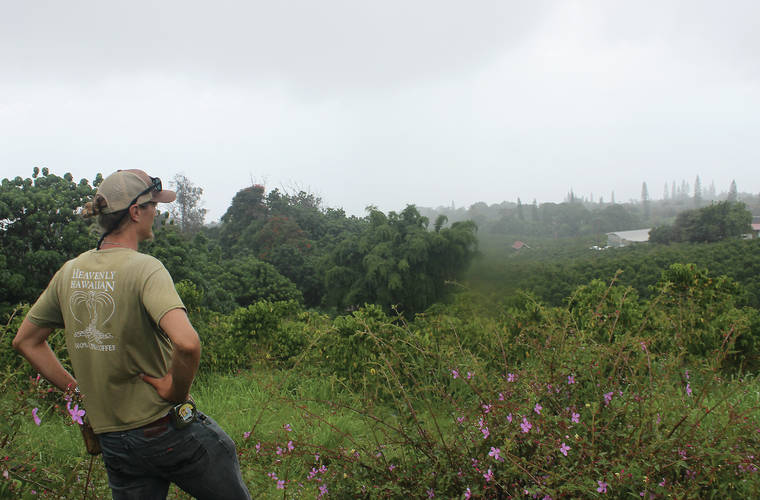KAILUA-KONA — A combination of above-average rainfall and vog-free skies appears to have set up Kona coffee farmers for a better season this year, but a couple challenges are cropping up.
That relatively positive outlook is good news in the wake of a 2018-19 season blocked by a thick layer of vog amid the Kilauea Volcano eruption and a dismal 2017-18 attributed to reduced production. U.S. Department of Agriculture statistics have not been released for last season, however, production and value were down more than 10% in 2017-18 and the season prior.
“This year, we’re seeing a much bigger crop which is good. A lot of farms took a beating last year with the poor harvest,” said Suzanne Shriner, a Kona coffee farmer and president of the Kona Coffee Farmers Association. “We’re thinking this is going to be one of the better years out of the last five years, and that makes a lot of people happy.”
Ample precipitation throughout much of the year over the Kona coffee belt region, which extends from about Makalei in North Kona to Milolii in South Kona, or into Ka’u, depending on whom you ask, paired with unimpeded sunlight amid a lull in volcanic activity have resulted in coffee trees chock full of plump red, yellow and green cherry ready to pick and become what the world knows as Kona coffee. Harvest is already underway, a month earlier than normal.
“Our first rounds at the lower elevations were just massive,” said Shriner, owner of Lions Gate Kona Coffee Farms, which has harvested about 30% percent of its 15 acres of coffee in Honaunau. “In fact, our first round was almost bigger than all the coffee we picked last year. It was so good.”
The coffee being plucked from the trees is also physically larger in size, thanks in part to the precipitation.
“Bigger beans are better. We get more money for them on the market,” said Shriner. “The biggest beans typically are what we call ‘extra fancy,’ and those have probably a 30% price bonus in the market.”
Heavy cherry is also particularly good when the average pay per pound, right now, is about $2.15.
“Record prices,” Shriner said of the going rate for this year’s crop. “It’s good for farmers, definitely.”
EARLY CONCERNS
Andrea Kawabata, a Kealakekua-based extension agent for the University of Hawaii’s College of Tropical Agriculture and Human Resources, agreed Friday that yields this year “should overall be better than last season.”
But as seems to always be the case with farming and the unknowns surrounding the industry, there’s going to be challenges that pop up. This season, Kona coffee farmers are facing diseases not typically seen in the region and a shortage of laborers, among other day-to-day issues.
Though the rainfall has helped with providing plenty of water for the start of a healthy crop and bolstering the fungus that combats the destructive coffee berry borer, it has created the humid conditions essential for the growth of diseases like cercospora and anthracnose, said Kawabata. Both are fungi and not new to the island — but they have made their presence known this season.
Anthracnose (Colletotrichum spp) creates lesions and can result in defoliation of the coffee tree while cercospora leaf spot, also known as “berry blotch” or Cercospora coffeicola, creates “brown eye-spots” and tends to cause coffee trees’ cherry to ripen prematurely.
“The tree will look like the beans are ripe and ready to pick, but when you process them they (the beans inside) are under-ripe — they are white — and that’s problematic for the quality of the coffee,” Shriner explained.
Bill Meyers, general manager at Hawaiian Heavenly Coffee Farms in Holualoa, was more blunt of the disease’s impact on the final product. While still edible, it’s quality is compromised.
“It’s worse than garbage because it gets into your mix and it sours the entire batch,” said Meyers. “A little bit of berry blotch, if you’re not careful, can ruin an entire pick and this is having an effect — everybody is being careful — but it’s across Kona.”
Kawabata said that due to the diseases, crop loss should be expected this year, particularly, “if no control was being made earlier in the season.”
Shriner said it’s too early to put an estimate on losses for this year’s crop.
“But we do know that we’re going to see some (farms) far worse than others,” she said.
‘CAUTIOUSLY OPTIMISTIC’
Luckily, Heavenly Hawaiian Coffee Farms caught the blight early and began spraying immediately to combat the diseases, Meyers and Farm Manager Ray Taggart said Friday.
“I think we’re going to get ahead of it, but the people who aren’t paying attention might have issues with it,” said Taggart, noting that the rainfall is also depleting nutrients to the plants by washing away fertilizer, creating more work and cost.
The company remains “cautiously optimistic” after what Taggart and Meyers said early on was looking to be shaping up for a better season than the past couple years. Last year was “horrible” and the company ended up taking a 40% hit due to reduced production they attributed to the volcanic eruption’s impact on precipitation and sunlight.
“The rain (this year) brought us the extra rounds of flowers — and it helps the trees in general — but,” said Meyers before Taggart jumped in, “it’s a little too much of a good thing.”
According to National Weather Service Senior Hydrologist Kevin Kodama, the Kona coffee belt region has experienced consistent, but above-average rainfall this year, as forecast, with August being a “very wet month.”
In fact, the highest monthly total of 15.96 inches (339% of average) was recorded at the Waiaha rain gauge; and all gauges along the belt reported more than 10 inches of rainfall during August. At Waiaha, there were six days that more than an inch of rain fell and only five days with no measurable precipitation.
“It’s been a while since we’ve seen that kind of rainfall,” Kodama said Friday, noting that gauges along the belt go back about 28 years.
And it’s probably going to be around for a bit, at least until mid-fall when sea surface temperatures cool down, he said explaining the warm waters off the coast help fuel precipitation over the region.
Another challenge farmers are seeing is a lack of laborers to strip the cherry as it ripens to a perfect jewel red in the fields.
It’s not a new problem for the Kona coffee industry, especially in the current national climate with concerns or even fears over documentation of migrant laborers, and low unemployment locally. But it’s been compounded this year by the crop’s early arrival farmers are seeing, and the possibility of fewer but larger picks due to the weather.
“Most of our labor doesn’t come in until September,” Shriner said, who like other farmers began harvest in July. “A lot of people are scrambling right now to get enough pickers to get the coffee out of the field.”
That scramble means sharing laborers to ensure the cherry is picked at its peak, before it goes to waste, Meyers and Taggart said Friday. Their “regular” crew isn’t expected to arrive until this week.
“When we can get the labor on the mountain, people share because it’s the only way we can get through,” Meyers said. “We’re sending 25 of our pickers to our neighbors today because she’s raisining and we’ve got to help her got her crop off the trees. … And people will do the same for us, too.”









